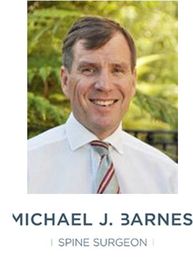Central Auckland, East Auckland, North Auckland, South Auckland, West Auckland > Private Hospitals & Specialists >
Michael Barnes - Spine and Orthopaedic Surgeon
Private Service, Orthopaedics, Paediatrics, Spinal
CERVICAL LAMINOPLASTY
Key Points
- Pressure on the spinal cord in the neck may cause pain in the arms, numbness or weakness in the arms or hands and numbness, weakness or unsteadiness in the legs.
- This is a very serious condition and requires early surgical treatment so the weakness does not become permanent.
- Surgery usually stops the condition worsening and if performed early some patients experience excellent recovery of numbness, weakness or unsteadiness.
- Surgery is performed through a vertical incision on the back of the neck.
- No fusion is performed.
- Recovery of spinal cord function usually occurs progressively over weeks or months and can go on occurring for a year or more.
- Most patients inevitably worsen without surgical treatment. Up to 5% of patients may be temporarily weaker following surgery and perhaps 1% of patients permanently worse following surgery.
Frequently Asked Questions
The weakness and numbness in my arms and legs is not recovering as quickly as I would like. Should I worry about this?
It is always good if recovery commences within days or a week or two of surgery. Don’t be too worried if there is no improvement within this time as there is the potential for the spinal cord to recover for up to a year or longer following surgery.
What do I do with the dressing?
The stitches are under the skin and will dissolve. The dressing is waterproof and you can shower in it. One week after leaving hospital simply peel it off as if it were a big “band aid”.
Under the dressing you will find steri strips (tapes) holding the skin edges together. These may come off with the dressing but otherwise remove them one week later if they have not fallen off.
Will I need physiotherapy treatment?
Most patients will benefit from physiotherapy treatment to help regain strength in the arms and the legs and in the neck muscles once the cervical collar is no longer required.
General Information
Pressure on the spinal cord in the neck may cause pain in the arms, numbness or weakness in the arms or hands and numbness, weakness or unsteadiness in the legs.
Pressure on the spinal cord in the neck occurs in a small proportion of people as the spine ages and the spinal canal narrows due to a build up of bone around the discs or the joints in the neck. This is a very serious condition and requires early surgical treatment so the weakness does not become permanent.
Surgery usually stops the condition worsening and if performed early some patients experience excellent recovery of numbness, weakness or unsteadiness.
Surgical Procedure
Surgery is performed under general anaesthesia with the head secured in a clamp. It is performed through a vertical incision on the back of the neck.
The bone on the back of the spine (lamina) is thinned on one side and divided on the opposite side then hinged away from the spinal cord to increase the cross sectional area of the spinal canal. The bone is held away from the spinal cord by tiny metal plates and screws. No fusion is performed.
Post Operative Course
The day after the surgery the drain is removed from the neck, the urinary catheter is removed and patients commence standing and walking.
Patients go home after several days when they can get in and out of bed, up and down stairs and their pain is under control with oral medication.
A soft cervical collar is worn for four to six weeks.
Recovery of spinal cord function usually occurs progressively over weeks or months and can go on occurring for a year or more.
Recovery of function is incomplete if the spinal cord is permanently damaged prior to surgery.
Most patients will not feel safe driving for at least six weeks following surgery.
Complications
Most patients inevitably worsen without surgical treatment. Up to 5% of patients may be temporarily weaker following surgery and perhaps 1% of patients permanently worse following surgery.
Occasionally weakness of the shoulder muscle develops post operatively (C5 nerve palsy). This can be severe and does not always recover completely.
Stiffness and weakness in the neck usually resolves progressively over months or up to a year.
Infection occurs in 1% to 2% of patients.

